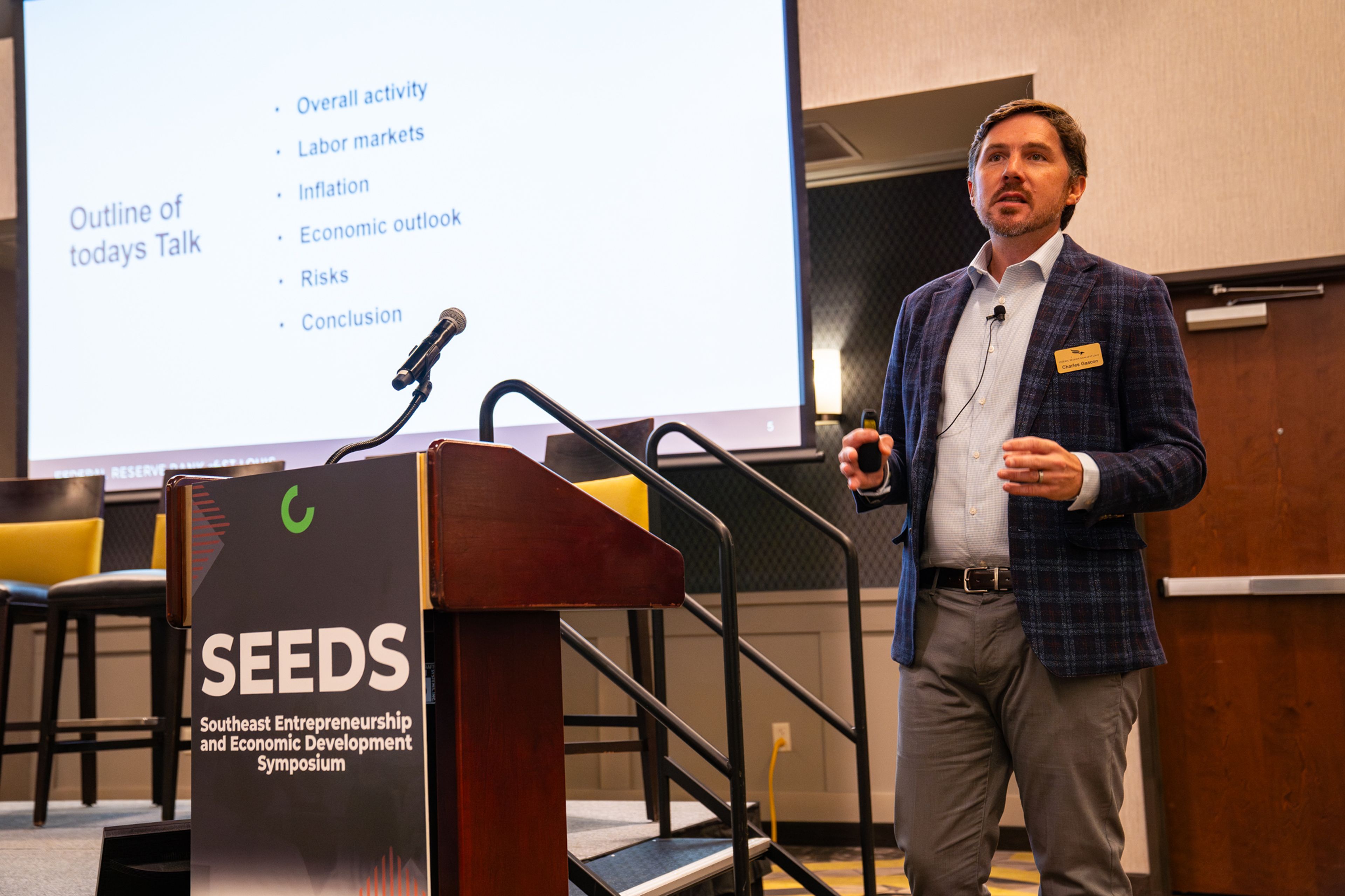Federal Reserve economist predicts slow but steady economic growth for 2025 at SEEDS conference presentation
Federal Reserve economist Charles Gascon forecasted slow but steady economic growth for 2025, highlighting wage and unemployment rates and shifting consumer behavior at the SEEDS conference in Cape Girardeau.
The Southeast Entrepreneurship and Economic Development Symposium (SEEDS) returned to Cape Girardeau on Thursday, Nov. 14, bringing with it a slew of discussion on the national and regional economy.
Charles Gascon, senior economist and research officer for the Federal Reserve Bank of St. Louis, was one of several presenters at the conference. He provided a regional economic update, sharing statistics from various business markets and how they related to his Federal Reserve District.
“The broad picture we’re looking at is pretty much the same: really strong growth coming out of the pandemic, a pretty rapid slowdown as we got into 2022 and then movement upward in the last couple of quarters with pretty steady growth in that 2% range,” he said.
The St. Louis district covers Eastern Missouri, Western Kentucky and Tennessee, Southern Illinois and Indiana, Northern Mississippi and the entirety of Arkansas. Gascon said sentiment from his contacts within the district is more pessimistic than for the nation as a whole.
“But at the same time, we have seen since the beginning of 2023, generally more and more of our (national) contacts are telling us that they see signs that things are getting better. They switch from pessimistic to neutral or going from neutral to optimistic,” he said.
Consumption dropped off during the pandemic, Gascon said, with government payments providing more disposable income to increase consumption once it had subsided.
“This is ultimately one of the big drivers of some of these inflationary pressures that we saw. Supply in the economy was constrained, we had a lot of supply chain disruptions, but at the same time consumers had a lot of money to spend, so with really strong demand we saw really strong consumption growth going forward,” he said.
The households with the top 40% of income provide a major portion of consumption, with lower-income households having much less spending power. Many low-income households are now living paycheck-to-paycheck. Credit card delinquency rates rose across all income levels since the pandemic.
“That’s very concerning for those low-to-moderate-income communities across the nation that the savings just (aren’t) there as opposed to a couple years ago. The excess savings have been depleted,” Gascon said.
Retailers are increasingly reliant on discounts and incentives to get customers through their doors because so many of them are cautious about spending money nowadays, Gascon added.
“Customers are increasingly price sensitive. There’s a hospitality contact in St. Louis that I talk to that runs an overall entertainment venue … you can buy a bundle package, it’s $50 or about that. They haven’t changed the price in about five years. They had more complaints about the price of their bundle package today than ever before,” he said.
Most inflation remains in the housing and service sectors, not in energy and goods. Gascon said some 80% of business contacts he’d spoken to said they felt they could raise prices without losing customers.
In other industries, the tourism and hospitality markets have been seeing strong growth with signs of recent slowing, he said. The manufacturing market is seeing more goods sent to places where they can sell at a lower price point — for example, ingredients going to a grocery store instead of a restaurant.
Gascon’s real estate contacts are optimistic, he said, expecting housing demand to grow in 2025. Existing home sales are relatively weak but an uptick in new construction could alleviate housing pressures.
In the St. Louis Federal Reserve District, around the same number of companies are expected to increase and reduce employment, with a slightly higher rate of businesses looking to offload employees on a national level. Broadly speaking, though, Gascon said layoffs remain rare.
“With respect to hiring, the general sense is there’s not a whole lot of expected massive expansion of unemployment. Workers are being hired to replace departing workers and that's what’s continuing to generate new opportunities as workers turn over the market,” he said. “… This is still a very, very tight labor market, so there’s still a lot of competition for labor. It’s by no means easy but it’s a much better balance than it was just a couple of years ago.”
Medium wage growth stands at around 5% now versus 3% pre-pandemic, Gascon said, which could be seen in a positive or negative light. Either workers are increasing their productivity and are being rewarded for their efforts, or they expect the cost of living to rise and expect compensation thusly.
Gascon said the expectation is for economic growth to slow down in 2025 and for the unemployment rate to tick upward slightly. It currently stands, nationally and regionally, at pre-pandemic levels of around 2% to 4%. Not many people are voluntarily quitting their jobs, so there are simply fewer jobs available.
“There are just very few businesses that I speak to that tell me they’re very bullish and they plan to hire a whole lot of workers, that they see a lot of job growth in the coming months,” Gascon said.
The SEEDS conference took place at Drury Plaza Conference Center, 3351 Percy Drive in Cape Girardeau. Presented by the Harrison College of Business & Computing at Southeast Missouri State University and the Cape Girardeau Area Chamber of Commerce, it was the sixth conference of its kind.
Connect with the Southeast Missourian Newsroom:
For corrections to this story or other insights for the editor, click here. To submit a letter to the editor, click here. To learn about the Southeast Missourian’s AI Policy, click here.









